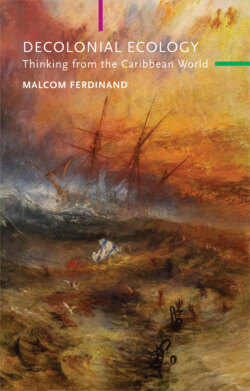Читать книгу A Decolonial Ecology - Malcom Ferdinand - Страница 24
Foundations of colonial inhabitation: land grabs, massacres, and land clearing
ОглавлениеInhabiting is not self-evident, hence the explicit precision in the deed creating the Compagnie de Saint-Christophe, where it is a question of “rendering these islands inhabited,” so that it is this doing, in the sense of this acting, that makes inhabitation possible. The acts that colonial man uses to establish his inhabitation constitute the foundations of colonial inhabitation. Three main acts consecrate the principial violence of colonial inhabitation. The first is land grabbing. Colonial inhabitation presupposes the obvious legitimacy of the appropriation of these islands by European colonists and the use of any force necessary to carry out this project. Let us remember that the Amerindians did not have the concept of private ownership of the land.11 This usurpation is accompanied by a set of symbolic gestures directed at the same Europeans. For example, the first act of Christopher Columbus when he arrived in Guanahani in 1492 was to rename the island San Salvador and to become its viceroy and governor. This baptism of the island and his self-declaration as governor were explicitly addressed to the members of his expedition and refer to the collective imaginary of the Spanish Crown. Likewise, in the deed of association for the Compagnie de Saint-Christophe, it is specified that it is a matter of a “faithful association between Us.” When du Plessis and de L’Olive arrived in Martinique with the intention of colonizing it, their first act was to plant the cross symbolizing that this land had been taken.12
The second act founding colonial inhabitation is land clearing. The French “felled” the woods. Far from being merely a circumstance of the French colonization of the Caribbean, cutting down the forests was a condition for inhabiting it. It was necessary to “kill” the woods for colonial inhabitation to be possible, so that these islands can be “inhabited.” Clearing the land was a very difficult task for the first colonists of Saint-Christophe because of their lack of both experience and tools.13 Du Tertre recounts that, when the land was cleared, it released “poisonous vapours” that caused a disease commonly known as coup de barre or sudden fatigue, which contributed to a high mortality rate among enlisted men.14 Myriam Cottias shows that in the Antilles, between 1671 and 1771, recruits had a mortality rate of 25 percent per year.15 Of course, the French colonists were not the only ones to cut down trees. The Amerindians also cut down trees in order to carry out their own agriculture. The difference is that colonization establishes the following relationship: to inhabit is to clear the land, to inhabit is to cut down trees. Colonial inhabitation only begins from the moment that the tree is felled.
Finally, the third act founding colonial inhabitation is the massacre of Amerindians and violence inflicted upon Amerindian women. These massacres were the foundation of colonial inhabitation and were recounted at length by Bartolomé de Las Casas.16 Concerning the French experience in the Caribbean, it was on the ashes of the massacred Caribs that the first French colony in Saint-Christophe was established in 1625 by the first French colonists, under the aegis of d’Esnambuc. The island of Saint-Christophe was occupied by the Caribs, the English, and the French. Pretending that they were avoiding an ambush by the Caribs, who would have tried to drive them out, the English and French, by mutual agreement, decided to massacre all the Caribs of the island and those who would come to it, as Father Du Tertre recounts: “… they stabbed almost all of them in their beds, on the same night, saving only a few of their most beautiful women in order to abuse them and make them their slaves; 100 or 120 of them were killed.”17
This account shows the entanglement of the ideology of colonization with that of male domination, which transcends ethnic boundaries. Colonial inhabitation is explicitly gendered. It is about slaughtering men and raping women, pitting the “savages” against the inhabitants. Colonial inhabitation was established upon the massacre of Amerindians and the possession of the bodies of Amerindian women, a true enactment of the principle of othercide.
